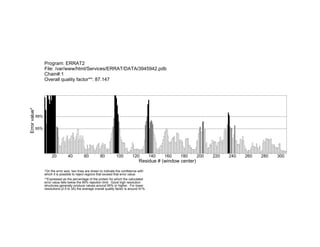
Swiss model evaluation
- 1. Chain#:1 File: /var/www/html/Services/ERRAT/DATA/3945942.pdb Overall quality factor**: 87.147 Program: ERRAT2 Residue # (window center) 95% 99% *On the error axis, two lines are drawn to indicate the confidence with which it is possible to reject regions that exceed that error value. **Expressed as the percentage of the protein for which the calculated error value falls below the 95% rejection limit. Good high resolution structures generally produce values around 95% or higher. For lower resolutions (2.5 to 3A) the average overall quality factor is around 91%. Errorvalue* 20 40 60 80 100 120 140 160 180 200 220 240 260 280 300
- 2. Chain#:1 File: /var/www/html/Services/ERRAT/DATA/3945942.pdb Overall quality factor**: 87.147 Program: ERRAT2 Residue # (window center) 95% 99% *On the error axis, two lines are drawn to indicate the confidence with which it is possible to reject regions that exceed that error value. **Expressed as the percentage of the protein for which the calculated error value falls below the 95% rejection limit. Good high resolution structures generally produce values around 95% or higher. For lower resolutions (2.5 to 3A) the average overall quality factor is around 91%. Errorvalue* 320 340 360 380
